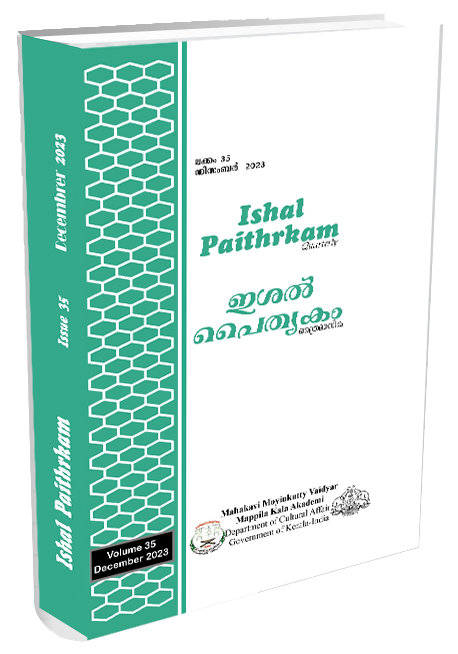Subversion of Phonic Speech through Aphonia inVijay Tendulkar’s Silence! The Court is in Session
Abstract
This paper focuses on the aphonic nuances of language in Vijay Tendulkar’s Silence! The Court is in Session and how it works towards subverting the superfluity of phonic speech and phallogocentric practices. Aphonic speech refers to the mouthed or suggested nuances of speech lacking phonation as opposed to articulate speech sounds. Silence is a subversive leitmotif in the play, rejecting militaristic masculine discourses and escaping the determinacy of meaning. Silence! The Court is in Session, the first Tendulkar play to become part of the New Indian Drama phenomenon of the sixties, is based on the 1956 short-story, Die Panne (Traps) by Swiss playwright Friedrich Dürrenmatt. The play presents a miniscule cross-section of Indian society that passes phallic decree in the name of verdict, using the extended metaphor of the court. The paper focuses on the aphonic nuances of language in the play as it works towards subverting phonic discourses, and presents it as dissociated speech as unmoored from the body.
The court in the play stands as a metaphor of the patriarchal society where hegemonic norms are reinforced through the tenor of command. The court also embodies the laws whereby woman is precipitated into the symbolic order of signification. The court has the final say in any civil construct imposing the final judgement, as does the prototypal male in Indian society. The reiterating statement of the court, “Silence! The Court is in Session” in the imperative forms the title of the play, and works analogically to Mr.Kashikar doggedly silencing his wife or Damle silencing Benare in a patriarchal society. The monologic verdict is the final decree the woman has to abide by, rendering her a passive linguistic construct. The court as metaphor analogical to the patriarchal system is worked out perfectly by the playwright in the sense of legitimising these practices. Mrs Kashikar hits the nail on the head when she likens the trial of the court to the trial of a woman ( p. 73). The law book held by Samant, a book that dictates the rules, attests to lack of linguistic agency for women and preaches discursive authority. It attests to the logocentric nature of our episteme at the elementary stage of meaning production or law-making. There is persistent reference to this book later as Rokde tries to instruct himself on the underlying rules of patriarchy. Sukhatme declares: “No allowance must be made because the accused is a woman” (p. 115). The acoustic effects in the play function at a metaphoric level. This is echoed with the reiterating command ‘Silence! The Court is in Session’ in a tenor suggestive of epistemic violence.
Western metaphysics has been built on dialectical pairs where the binaries of man/woman function analogical to speech/silence, active/passive, sanity/insanity, etc. This phenomenon is also reflected in linguistic structures and theories where women are viewed as the ‘aporias’ in a phallogocentric system, or as latent semiotic flux in dominant symbolic systems. It can be located in instances where sexism functions parallel to speciesism as women are equated with silence or the indeterminacy of meaning. This practice translates into domestic codes or extends to domestic spaces where women are restricted to silent spaces like the kitchen based on mechanical or housekeeping function, or the storeroom analogical to the womb, limited to storage functions. This kind of persistent epistemic exclusion limits them from contribution to knowledge production. Through these patriarchal structures, they are exacted into silence and subservience.
Downloads
References
Agamben, G., & de la Durantaye, L. (2012). Image and Silence. Diacritics, 40(2), 94-98.
Bandyopadhyay, S. (2003). Introduction. In Collected Plays in Translation (pp. 569-584). Oxford University Press.
A Conversation with Sir Vijay Tendulkar. (2022, October 2). www.passionforcinema.com. Retrieved September 22, 2023, from http://passionforcinema.com/a-conversation-with-sir-vijay-tendulkar
Easton, M. (2009, Juky). Saint Lucy, the Silent Woman, and Subversive Female Speech in the Middle Ages. Different Visions: New Perspectives on Medieval Art, 2.
Ferguson, K. (2002). Silence: A Politics. Contemporary Political Theory, 1, 1-17. https://errantsound.net/wp/wp-content/uploads/2017/06/session5_kennanferguson_silence_a_politics.pdf.
Gal, S. (2009, July 2). Between Speech and Silence: The Problematics of Research on Language and Gender. John Benjamins e-Platform. Retrieved September 25, 2022, from https://www.jbe-platform.com/docserver/fulltext/rapip.3.1.01gal.pdf?expires=1663931826&id=id&accname =guest& checksum=AD7BAB103BDD04748C9A1DA1C9BB 0E4C.% 20Accessed%2024%20September%202022
Godart, C. (2016). Silence and Sexual Difference: Reading Silence in Luce Irigaray. Journal of Diversity and Gender Studies, 3(2), 9-22.
Heidegger, M. (n.d.). Heidegger, Martin: Hölderlins Hymnen “Germanien” und “Der Rhein”. Gesamtausgabe, 39.
Heidegger, M. (1980). Heidegger, Martin: Hölderlins Hymnen “Germanien” und “Der Rhein”. Gesamtausgabe, 39.
Irigaray, L. (2002). Between East and West: From Singularity to Community. Columbia University Press.
Irigaray, L. (2002). Luce. Between East and West: From Singularity to Community. Columbia University Press.
Sontag, S. (2021, September 17). The Aesthetics of Silence | Susan Sontag (1967). Mainstream Weekly. Retrieved September 22, 2023, from http://mainstreamweekly.net/article11464.html
Tendulkar, V. (2003a). Characterization and Structure. In Collected Plays in Translation (pp. xxvii-xxxix). Oxford University Press.
Tendulkar, V. (2003). Collected Plays in Translation. Oxford University Press.
Tendulkar, V. (2003b). Preface. In Collected Plays in Translation (pp. vii-xxvi). Oxford University Press.
Downloads
Published
Issue
Section
License
Copyright (c) 2025 ISHAL PAITHRKAM

This work is licensed under a Creative Commons Attribution-NoDerivatives 4.0 International License.

